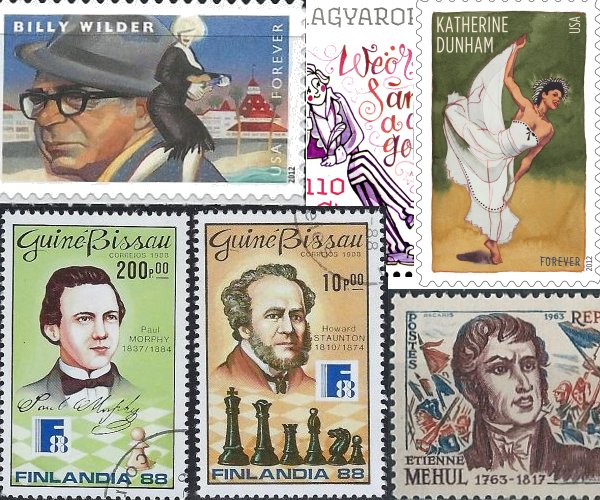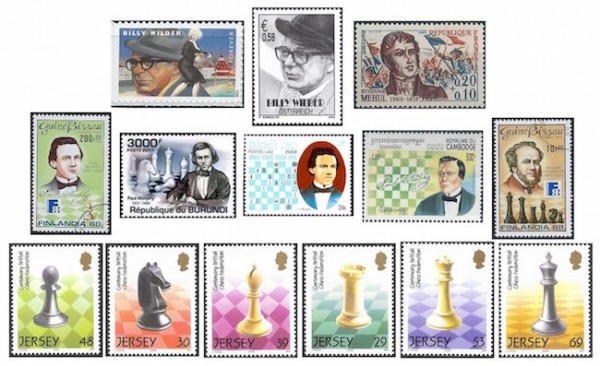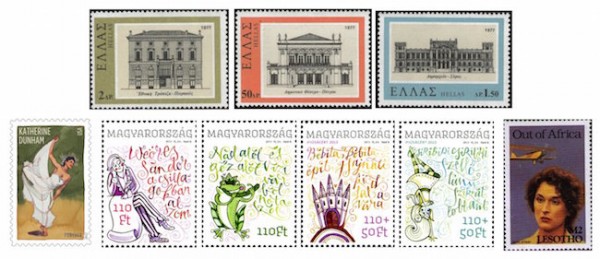The Arts on the Stamps of the World — June 22
An Arts Fuse regular feature: the arts on stamps of the world.

By Doug Briscoe
Today’s champion is unquestionably Paul Morphy, in the chess arena, anyway. Otherwise, I think Billy Wilder tops the rather short list.
The great, great director Billy Wilder (born Samuel Wilder; June 22, 1906 – March 27, 2002) was born in the Austro-Hungarian Empire in what is now the extreme south of Poland. It was his mother who called him “Billie”. (She, his grandmother, and his stepfather were all murdered in the Holocaust.) Wilder started out as a journalist and turned to screenwriting when he was still in his early twenties. He wrote the screenplay for the popular 1931 movie Emil and the Detectives, based on the novel by Erich Kästner. When the Nazis came to power a couple of years later, Wilder fled Berlin for Paris (it was there that he directed his first film) and then Hollywood, becoming a U.S. citizen in 1934. The string of terrific pictures that Wilder went on to write and direct in rapid succession were The Major and the Minor (1942), Five Graves to Cairo (1943), the incomparable Double Indemnity (1944), and The Lost Weekend (1945). Another remarkable (consecutive!) sequence followed with A Song Is Born (1948, screenplay only), Sunset Boulevard (1950), Ace in the Hole (1951), Stalag 17 (1953), Sabrina (1954), and The Seven Year Itch (1955). Later still came Witness for the Prosecution (1957), Some Like It Hot (1959), and The Apartment (1960). The next year he was planning to direct a new Marx Brothers comedy which was to have been called A Day at the U.N., but Chico Marx died, and the project was shelved. Sadly (and unforgivably), it appears that, from age discrimination alone, Wilder himself was largely “shelved” by the Hollywood apparatus after his last film Buddy, Buddy (1981). He lived on for another twenty years with the consolation of his extensive art collection, dying on the same day as Milton Berle (birthday next month) and Dudley Moore.
Étienne Nicolas Méhul (22 June 1763 – 18 October 1817) was primarily an opera composer, but he also wrote a number of songs and pot-boilers in support of the French Revolution, some of which were commissioned by his friend Napoleon. One of these, the Chant du départ, became the official anthem of the First Empire. His four completed symphonies were recorded in 1992 for Nimbus. He is one of the many renowned composers buried at Paris’s Père Lachaise Cemetery (along with Chopin, Rossini, Cherubini, and Gossec, to name a few).
A child prodigy, New Orleans-born Paul Morphy (June 22, 1837 – July 10, 1884) defeated a visiting Hungarian chess master at the age of twelve. For three years he had already been acknowledged as one of the best players in the city. (Gen. Winfield Scott had visited New Orleans at that time and asked to meet the city’s strongest player; when the nine-year-old Morphy was trotted out Scott thought he was being trifled with but, reassured, sat down to play. After two quick defeats the general prudently withdrew from the field.) At twenty Morphy was acclaimed as the best American player, and after touring Europe in 1858 was regarded as the best in the world. The next year he retired from play and refused all invitations to matches, leading some to dub him “The Pride and Sorrow of Chess”. He died of a stroke thought to have been brought on when he immersed himself in a cold bath after a long walk on a hot day.

Now it just so happens that another chess expert (thought to be the world’s strongest player from 1843 to 1851, but who declined to test his mettle against Morphy) died on Morphy’s birthday in 1874. This was Howard Staunton (1810 – 22 June 1874), the man whose name is inextricably attached to the standard design of chess pieces in use throughout the world now for over a hundred and fifty years. The actual designer was one Nathaniel Cooke, who created his set of pieces in the 1830s and patented them in 1849. As editor of the Illustrated London News, Staunton wrote a regular column on the game, and he was approached by Cooke to advertise the set in the paper. As a result the set came to be known as the Staunton chess set. Staunton, who was also a Shakespearean scholar, organized the first international chess tournament in 1851, which was won by the German master Adolf Anderssen (whose birthday is coming up on July 6). Staunton’s stamp, you may have noticed, comes from the same Guinea-Bissau set from which the leftmost Morphy stamp derives, and in addition I display a set of stamps from the Bailiwick of Jersey showing each of the standardized pieces. (Note: I can’t credit Nathaniel Cooke on his birthday for this, because no online source I could find tells us even the year of his birth, nor the year of his death.)
The German architect Ernst Ziller (22 June 1837 – 4 November 1923) became a citizen of Greece and built almost all of his structures, some 500 of them, in that country. Fully half of a 1977 set of six Greek stamps devoted to architecture honor buildings designed by Ziller: from left to right, the National Bank of Greece in Piraeus, the Municipal Theater in Patras, and Ermoupolis City Hall in Syros. After studies in Dresden and Berlin, Ziller and his brother Moritz sought employment in Vienna, where Ernst worked with the Danish architect Theophil von Hansen (birthday next month), who brought Ziller along for a project in Athens. This was Ziller’s introduction to Greece, though he didn’t make his home there until some years later. Ziller has a teeny-tiny article on the English language Wikipedia page, a substantial one in Greek, and a huge one in German.
Multi-talented African-American dancer, choreographer, and writer Katherine Dunham (June 22, 1909 – May 21, 2006) was a published author at twelve, as a short story appeared in The Brownies’ Book, a magazine for black children that had only been established two years before. In high school she played a variety of sports and held office in French club and on the yearbook staff. Later she studied anthropology and dance. Her studies took her to the Caribbean, and she earned her degree, obviously a rarity for black women of the day, in 1936. Thereafter she concentrated on dance, having opened the Negro Dance Group in 1933 and touring the U.S. with the company. In 1948 she took it to Europe and for the next twenty years performed abroad, visiting some 33 countries. Some of Dunham’s other signal accomplishments include: opening a school of dance in New York (1945); writing autobiographical volumes during a year off in Japan (1957), being the first African-American since 1933 (Hemsley Winfield’s work for The Emperor Jones) to choreograph for the Metropolitan Opera (1963); founding the Performing Arts Training Center in East St. Louis (1967), and, throughout her life, fighting for civil rights, and not only in the United States: once, by publicizing discrimination in a São Paulo hotel, she was responsible for a nationwide Brazilian anti-discrimination law. Extraordinary. Her stamp is a rather recent one from a set honoring four American choreographers.

Hungarian poet Sándor Weöres (22 June 1913 – 22 January 1989) published some poems when he was nineteen before earning his doctorate (with a dissertation called “The Birth of the Poem”) in philosophy and aesthetics. He traveled much and was a remarkable linguist, translating from English (Shakespeare, T. S. Eliot, Edward Lear, and Lewis Carroll), French, German, Italian, Latin, Chinese, Ukrainian, Georgian, and Slovenian. His own poems have been set to music by Kodály, Ligeti, Eötvös, and others. The inspiration for the centennial stamp designs (by Boglárka Nádi) came from a volume of Weöres’s poems that he had given as a gift to his wife Amy Károlyi, herself a poet and translator. Weöres had copiously hand-illustrated the book, and Nádi conceived the idea of illustrating lines from Weöres’s poetry in the same manner.
Meryl Streep (born June 22, 1949) is on a stamp from Liberia that, aptly enough, recalls her appearance in Out of Africa.
No stamps for writers H. Rider Haggard (22 June 1856 – 14 May 1925) nor Erich Maria Remarque (22 June 1898 – 25 September 1970).
A graduate of the University of Massachusetts with a B.A. in English, Doug Briscoe worked in Boston classical music radio, at WCRB, WGBH, and WBUR, for about 25 years, beginning in 1977. He has the curious distinction of having succeeded Robert J. Lurtsema twice, first as host of WGBH’s weekday morning classical music program in 1993, then as host of the weekend program when Robert J.’s health failed in 2000. Doug also wrote liner notes for several of the late Gunther Schuller’s GM Recordings releases as well as program notes for the Boston Classical Orchestra. For the past few years he’s been posting a Facebook “blog” of classical music on stamps of the world, which has now been expanded to encompass all the arts for The Arts Fuse.
